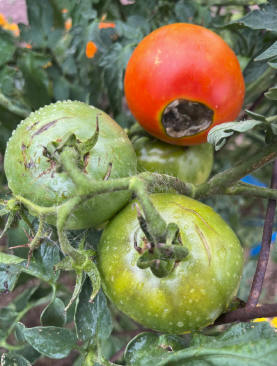|
 The red tomato on the upper right The red tomato on the upper right
is exhibiting blossom end rot.
|
(9/17) Many vegetable gardeners are acquainted with the dreaded blossom end rot, a disorder that leaves black, sunken blotches on the bottoms of fruits. While blossom end rot is usually associated with tomatoes, it also affects eggplants, peppers, watermelons, and cucurbits (a family of vegetables that includes melons, cucumbers, pumpkins, and squash).
A quick inspection of developing vegetables can reveal the first stages of the disorder. Blossom end rot begins with a small, leathery lesion on the blossom end of a fruit, which gradually expands in diameter until the bottom of the fruit is blackened. Variations of the disorder involve dark lesions appearing on the sides of fruit or inside the fruit flesh itself.
Blossom end rot occurs when fruit tissues receive insufficient calcium, causing the tissue to break down and die as a result. If left untreated, blossom end rot can result in a harvest of damaged, unsightly fruit, and may be a harbinger of other plant symptoms associated with calcium deficiency. A variety of possible culprits related to water, soil consistency, and soil chemistry can cause the disorder. The following gardening mistakes and soil conditions can produce blossom end rot.
(1) Insufficient water. Plants absorb calcium from the soil through their roots, However, plant tissues can only move calcium throughout the plant if adequate water is present. When vegetable plants have inadequate moisture due to insufficient watering, drought, high temperatures, or compacted soil, calcium cannot travel through the plant to reach the developing fruit.
Damaged plant roots are less efficient at moisture uptake than intact, healthy roots. Planting vegetables too close together or in compacted soil can damage roots. Excessive use of fertilizer can also burn plant roots, undermining their ability to absorb water.
To prevent blossom end rot in vegetables, water the plants regularly, especially during droughts and heat waves. Cultivate plants in well-drained soil that allows water to penetrate down to plant roots. Give each plant adequate space to prevent root damage from overcrowding. Add organic matter such as compost to the soil to enhance drainage and allow roots to develop normally. The application of mulch to garden plots can slow down moisture evaporation, allowing the soil to retain moisture for longer periods. If blossom end rot persists despite ample watering, the culprit may lie in the soil itself.
(2) Low calcium levels in the soil. If one’s vegetables are exhibiting blossom end rot, the soil may be deficient in calcium. A soil test, available through the Penn State Agricultural Analytical Services Lab, can reveal if one's soil has low calcium levels. To correct low levels of calcium in the soil, apply garden gypsum (calcium sulfate dihydrate) to the soil according to the package instructions. Gypsum is available for purchase from most garden centers. Be aware that gypsum is not a fast-acting soil amendment and may take months to weather down and incorporate into soil.
(3) Excessive fertilizing. Excessive use of certain fertilizers can produce chemical changes in the soil that prevent plants from making use of available minerals. When soil contains high concentrations of ammonium (NH4+), potassium (K+), and magnesium (Mg++), plants may struggle to absorb available calcium. To prevent blossom end rot, avoid over-fertilizing the soil, especially with ammonium-based nitrogen fertilizer, and monitor soil nutrient levels through yearly soil tests.
(4) High soil pH. Many vegetables prefer slightly acidic soil. For example, tomatoes thrive in soil with a pH of 6.2 to 6.8. However, vegetable plants may be unable to absorb available calcium if the soil is too alkaline, resulting in blossom end rot. A soil test can reveal if one's soil has the appropriate pH for growing a particular vegetable crop.
To lower high soil pH to desirable levels, apply garden sulfur according to the package instructions. Garden sulfur can be purchased from most garden centers. Refrain from applying garden lime (calcium carbonate) or using mushroom compost as a soil amendment, both of which will raise soil pH.
Before choosing vegetables to plant, research their soil pH preferences. Make sure that the pH level of one’s garden plot is appropriate for the desired crop. If necessary, take measures to adjust soil pH months before planting, so that soil amendments have time to work.
By taking proper care of vegetable plants and the soil in which they grow, blossom end rot can be prevented. Adequate water, sufficient and balanced soil nutrients, and correct soil pH are all essential for growing vegetables that are free of black blotches. A little research and planning can ensure healthy soil, healthy plants, and attractive vegetables.
Read other articles on growing herbs or vegetables